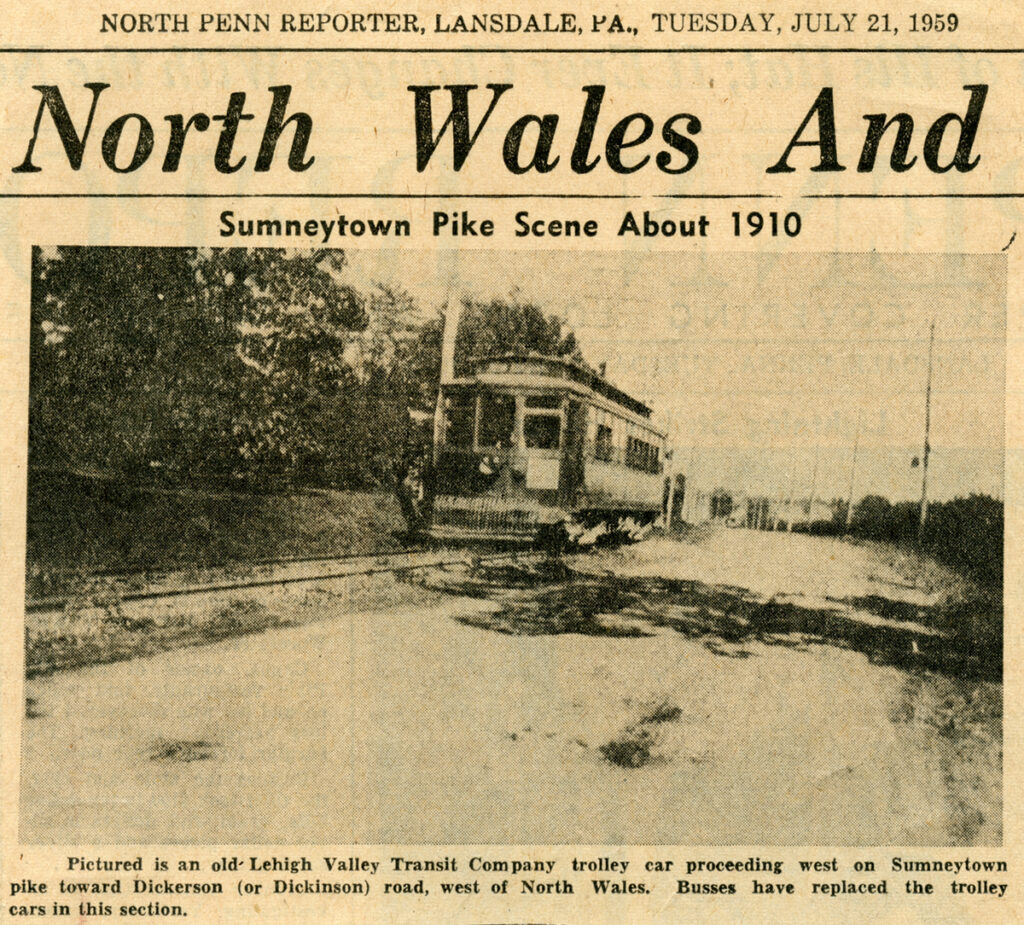This week we will talk about the old Dickerson farm in Upper Gwynedd Township, which came into the ownership of Leeds and Northrup in the 1950s. The site is today [2023] occupied by the Merck Upper Gwynedd complex opposite Parkside Place.
The Dickerson farm, or the greater part of it, was probably included within the original patent to Evan Hugh, who acquired 1068 acres in 1701, extending across Gwynedd Township in a narrow strip. Hugh Pugh, one of his sons, acquired this partition of his father’s grant, including also the Gordon and Beaver farms, or 307 acres in all. In 1718 this tract was sold to Cadwallader Foulke, who held it for fourteen years. In 1732 Robert Jones was the purchaser who the same year conveyed it to his son, John Jones.

In 1736 David Cummings bought 108 acres of John Jones and who, in 1760, conveyed to George Maris. He was the great grandson of the Maris who came to this country from Worcestershire, England, in 1683, and settled in Springfield, Delaware county. He was a prominent Quaker and said to be a preacher. He filled a number of important places of public trust, being for several years a member of the Assembly, Justice of the Peace, and Judge of the County Court. He left many descendants, among whom was Prof. George L. Maris, who was the head of the George School at Newtown. George Maris, the immigrant, died in 1705. In 1762, Maris sold to a more permanent owner, Mathias Lukens, who bought 180 acres which must also have included much of the Beaver farm. The new owner was supposed to have been the son of John Lukens, who came from Holland to Pennsylvania in 1688. He died in 1744, leaving a family of children, one of whom was Mathias, born in 1700.

A saw mill powered by the Wissahickon Creek was here during the ownership of Mathias Lukens. It is supposed that Lukens built the saw mill before the Revolution [American War of Independence]. In the assessment of his property in 1776, the saw mill is mentioned together with 130 acres, two horses and six cows. He had bought other lots, of some thirty acres, bordering the present Sumneytown pike. His will was made March 6, 1783 in which he ordered his executors to sell his property.
In 1786, a Quaker named Joseph Shoemaker bought the property comprising 91 acres of Joseph Lukens and John Evans, the executors. His last will was made March 5th, 1823, in which he ordered the sale of his property. In 1828 the buyer was Thomas Shoemaker, who, in 1830 conveyed to Emanuel Stilte, a native of Germany born in 1751.
Stilte was a blacksmith. During the latter period of his life he had his shop opposite the toll-gate [Sumneytown Pike at West Point Pike] and lived in the house owned in the early 1900s by John Schull. His death took place in 1839 at the age of 88 years and he lies buried in the Lutheran Cemetery at North Wales. He had a daughter born in 1780, who married a Reformed minister, Rev. Samuel Helftenstein.
We first hear of Helfenstein as the pastor of the Reformed Church near 4th and Race streets, Philadelphia. He was born in 1775. He built a large house at the corner of Sumneytown pike and Dickerson road, where he resided and finally died. He mostly rented the farm and saw mill to other parties. He was the pastor of the Reformed Congregation in the old Yellow Church, North Wales, for seventeen years, or from 1826 to 1843. His death took place October 17, 1866, at the age of 91. He left six children. Of these, two were also preachers, Albert and Samuel, Jr.
His son, Samuel B. Helfenstein, was well known in Montgomery county. He was a school teacher and a newspaper man, publishing the Norristown Defender for many years. He died about 1880. His uncle, Albert, the preacher, died in 1870 at the age of 69.
The second Samuel Helfenstein died in 1869, also aged 69. In 1855 Rev. Samuel Helfenstein conveyed the property to John Lutz of Whitpain for $6620. The latter was descended from a German family.
The death of John Lutz took place on November 3rd, 1861. During his ownership he had built a new saw mill. After his death the 69 acre farm was sold to Albert Dickerson who came from Whitemarsh. For some time after the Dickerson purchase the saw mill continued in operation, but gradually became disused.

In March 1913 the heirs of Albert Dickerson sold the farm to Raymond Mayhew, representing the Florex Gardens Company. The farm remained in the possession of Florex Gardens until sale of the property to Leeds and Northrup in the 1950s.
This post is sourced from a column entitled Early North Wales: Its History and Its People penned by long-time North Wales resident historian Leon T. Lewis. The article appeared in its original form in the July 21, 1959 issue of the North Penn Reporter.
